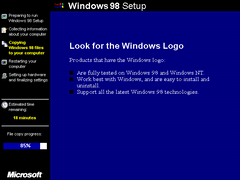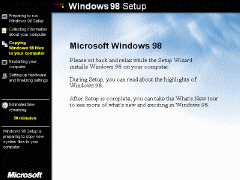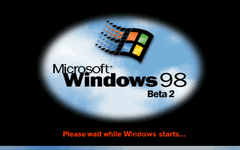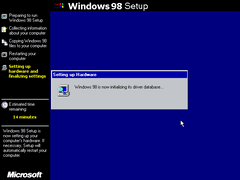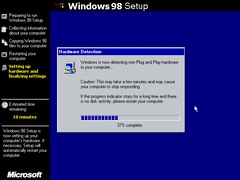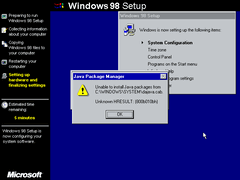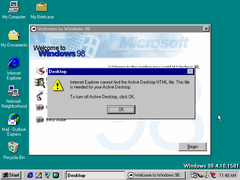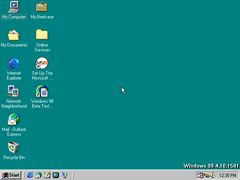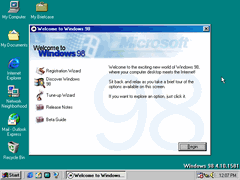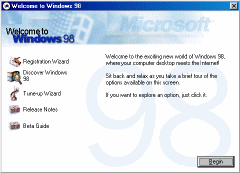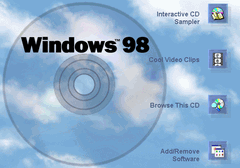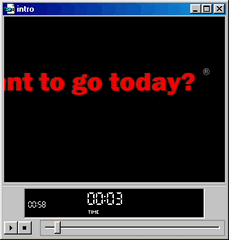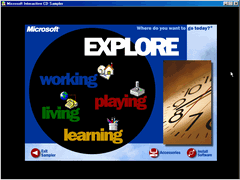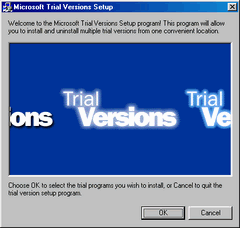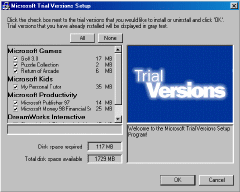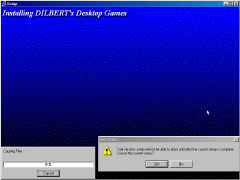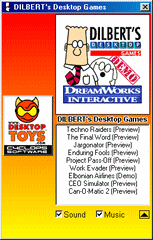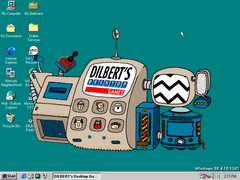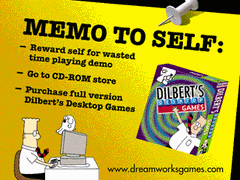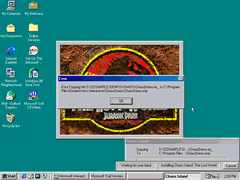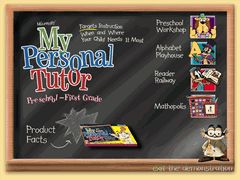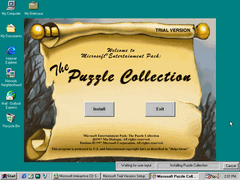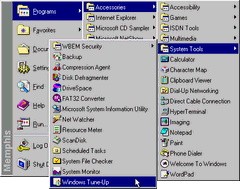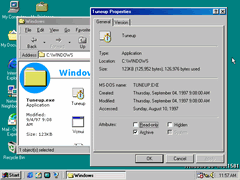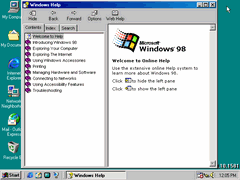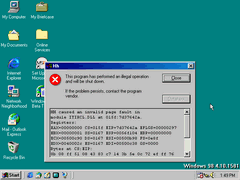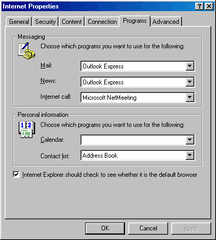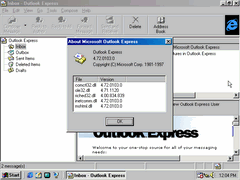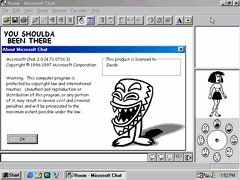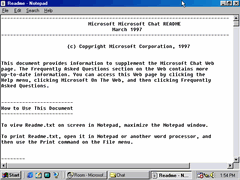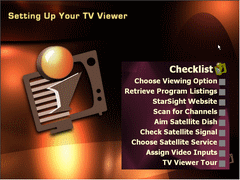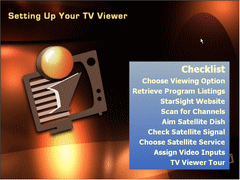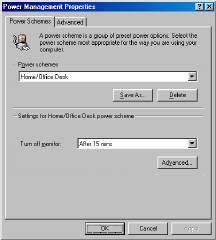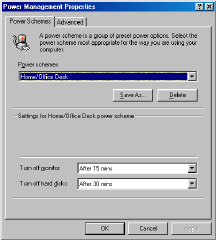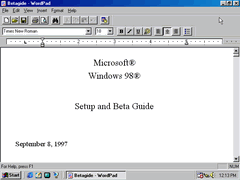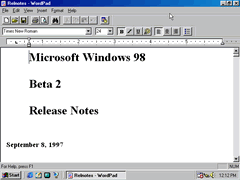Author: Blue Horizon
Completed: August 26, 2024
The setup billboard has a new slide added in, basically advertising the Windows sticker on OEM machines that comply with Windows 98's standards and hardware support. Aside from that, all the other slides remain unchanged from the previous build.
When running the installation in a higher color depth, however, you'd get a different experience as even more stock images have been added for each slide (minus the beginning and ending slides, which are now left blank). Apparently, that one extra slide was worth pushing for adding in all these people in, just look at those stiff smiles. It should also be pointed out that the Windows logo slide doesn't make it into the final release. This wouldn't be the only scandal regarding Microsoft stickers on OEM desktops, however...
It took a while, but they finally displayed SULOGO.SYS again after the first restart!
As usual, the fonts don't stay consistent throughout all stages of installation.
The hardware detection dialog has had its dialogue revised once more, this time being that which is used in the finalized build, as well as all future 9x builds.
A little side tangent; if we have two words that mean two different things and are pronounced the same, why don't we pronounce it two different ways? Oh, right, because the almighty English language said so.
Encountered this Java package error during installation, though it doesn't affect the outcome in the end.
The first time I booted into this build, it tried loading the Active Desktop presumably to load the channel bar. This isn't because I'm using a warez copy or anything like that, this is really how it is sourced from original copies.
On the desktop (which is usually missing Outlook Express in the quick launch bar, but for some reason installed itself after booting it up later on), the prohibition symbol icon linking to View Channels is reverted back to its proper state, the HTML icon for the beta testing website oddly uses a lower color depth, "The Internet" icon that had been around since Windows 95 now uses the blue "e" logo and is now named after what it really is, and Mail now has a subtitle of Outlook Express. That last change is really odd since if the application is named what it is to begin with, why not just make that the definite title instead? Either way, it didn't stick very long.
Of course, as soon as you boot into Windows, you're greeted with the Welcome dialog. This time, the "Beta Guide" option is brought back, along with another option which opens the release notes. This also reverts the change of "Tune-up Wizard" being called "Tune-up Scheduler" and goes back to being called the former, still in all of its toilet plunger glory (and some kind of stick behind it - perhaps a bowl brush?).
I forgot to mention in the last build that the video that plays at the beginning no longer plays here, but it is still present in the program's files in \WINDOWS\WELCOME\.
ALSO, the button is named "Tune-up Wizard", yet the description header reads "Window Tune-up". That's another typo to add to the list of times Microsoft doesn't use the plural word for window when referring to their product branding.
The button layout is the same as 1546's AutoRun, but the background is ripped straight from the Clouds.bmp file rather than the raw source image itself. As such, the background uses a different opaque CD image rather than mirroring the original to mask the Windows 95 branding. Although still a placeholder, is much less crudely put together.
Oh look, its the Windows 98 commercial- nah, just kidding. That's often misattributed to the CD sampler intro, which this build comes with now. The one difference I notice is that the copy commonly shared online doesn't have the "working, living, learning, playing" frames near the end that this one does. I'd need to look into if any localized copies have that variant, as this was the first Microsoft sampler to have localizations included with their respective copies of Windows. Beforehand, the English version would always be on all non-English copies of Windows 95, with some translations being exclusively distributed on standalone CDs.
Also of note is that the intro video oddly has trouble attempting to play when starting the sampler - hence why I chose to play the video using the ActiveMovie player here. You can still skip it, however. This also happens with the retail release too. Strange, considering the other samplers rarely had issues with playing the intro video at all every time.
This is pretty much the sampler that shipped with the retail release of 98. I'll only show any new trial software included with this iteration that wasn't in 1546.
A nice little graphic with text glowing, and a list of the trial software that it comes with. After installing the software, the checkboxes turn grey on subsequent loadings. One title failed to install altogether, as shown on the last slide.
Dilbert's Desktop Games has a unique installer interface, in that instead of showing a dialog telling the user installation is complete, it shows it as a message on the gradient background itself.
10 exclusive eXtreme desktop games!!! This game menu goes as far as to break interface guidelines by not having a visible close button anywhere. You actually have to hover over one of the smaller buttons on the bottom of the console to exit out properly. This was when programs felt the need to have skins on just about everything to stand out, a trait most commonly associated with media players from around this time.
The self-aware splash when exiting the demo.
Installing The Lost World prompts an error when copying the main executable, for some reason extracting it as a .TMP file. The demo remains unusable.
Goofy little claymation scientist demo. I haven't seen many people talk about this particular game, even when compared to the ActiMates dolls. I guess other edutainment companies like Humongous were really the main draw of attention during that time having more fleshed out and memorable characters.
Installation dialog for the Entertainment Pack's puzzle collection. All the games included are the same from when I showed them in build 1546. That about wraps up the CD sampler demos.
The Start menu itself is laid out almost the same, but with some slightly different positioning in the menu buttons if you look hard enough. Tune-up Scheduler has also been renamed to Windows Tune-up.
On top of the renaming, it's also been given a proper new icon instead of subsequently reusing the old Disk Cleanup icon.
Two control panel applets have updated their icons as well, those being Internet and Users. The latter of which now takes on its finalized form.
The interface for the HyperHelp viewer has been tweaked slightly, such as content directories no longer having expanding/collapsing plus and minus buttons next to their icons, and the picture depicting the window itself being removed for more simplistic instructions. The "Introduction" section has been renamed to "Introducing Windows 98" like it appears in retail.
Ironically, even just closing help windows always throws up an "illegal operation" error. That extra web-based code is really starting to get the better of its own stability... it could just be poor implementation of ITIRCL.DLL as it implies.
Instead of listing Outlook Express Mail and News as separate selection entries like in build 1577, it is now unified into one singular program in light of the updated version of OE.
Nothing really major to report about Outlook Express aside from the fact it has been bumped to version 4.72 from 4.71.
Included with the suite of Internet Explorer products comes Microsoft Chat; their own chat client that uses the IRC protocol with an interface that resembles comic panels and allows users to customize their character choice and add emotions to it. This was originally a downloadable program that was distributed as "Microsoft Comic Chat" alongside IE3, and now is prominently included with every copy of 98.
Before there was Comic Chat, Microsoft had another similar chat client in late-1995 called V-Chat, which used 3D characters instead of 2D cartoon avatars. During development of the then active Nashville project, it was originally meant as a precursor to a fully interactive 3D hub client which had voice chat capabilities, but ultimately never came to be.
The readme document included with Comic Chat, dated March 1997. Note how it says "Microsoft Microsoft Chat", presumably because they just hastily replaced the word "Comic" with "Microsoft" as the former word was dropped from the full title.
In TV Viewer, the checklist typically has a little swirl abstract type background which resembles the main background itself.
That's for previous builds, however. This is what it actually looks like in this build:
The new one now has just a light blue gradient for the background, with the info icon and checkboxes strangely missing. The rest of TV Viewer is pretty much untouched so far from what I see.
Left: build 1577, Right: build 1581
I don't know how far back this design layout goes, but initially in the Power Management dialog, you had to click an additional button to set how long before turning of the hard disks, as well as an option in the advanced tab for prompting a password when standing by. In this build, however, that disk activity option is now on the main window itself, though the password option is completely gone. Even the space for it was left behind.
I only noticed this because the icon for it was shown in the taskbar by default, and initially didn't think much of it. But strangely, that option is checked in the previous build, but still doesn't appear in the system tray. Missing implementation, perhaps?
Some updated documentation is included, which is actually dated four days after this build was compiled. I'll provide links to those documents here:
